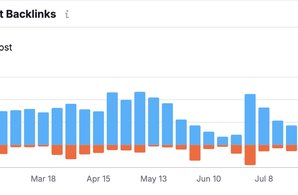What is SEO visibility?
- Home
- Knowledge Sharing
- What is SEO visibility?
SERP visibility is a metric that quantifies how often a website appears in search engine results relative to the total search volume for targeted keywords. It is expressed as a percentage, where a higher score indicates better search engine rankings and more significant potential for attracting organic traffic.
For online businesses, SEO visibility directly affects their ability to reach potential customers. A low search visibility score means the website is not appearing prominently despite relevant searches, leading to missed traffic, conversions, and revenue growth opportunities. Increasing SEO visibility should be a primary focus for maximizing online performance.
How SEO Visibility is Measured
SEO visibility score is measured by calculating the percentage of clicks a website receives for ranking keywords in search engine results, compared to the total possible clicks for those keywords. The formula considers the ranking position for each keyword: higher positions, such as those on the first page, contribute more to visibility than lower ones. Check website visibility you can with the help of tools like Sistrix or SEMrush. These services track a site's ranking positions for a set of keywords, calculate the potential traffic from those rankings, and then convert this into a visibility score. This metric reflects the quantity and quality of a site's keyword rankings.
Factors Affecting SEO Visibility
Several key factors affect SEO visibility, each contributing to a website's search performance:
- On-page optimization involves optimizing individual pages using relevant keywords in the content, headers, and meta tags. Adequately structured content that aligns with user intent helps search engines understand what the page is about, improving rankings.
- Off-page factors: Backlinks from authoritative websites signal trust and relevance to search engines, boosting visibility. The quality and quantity of backlinks and overall domain authority are critical for improving a site's position in search results.
- User experience: Search engines prioritize websites that offer a good user experience. Fast page load times and mobile-friendliness are essential, as slow or unresponsive sites lead to higher bounce rates, negatively impacting rankings.
- Technical SEO: A well-structured website is more accessible for search engines to crawl and index. Clear site architecture, proper use of sitemaps, and eliminating broken links or errors ensure search engines can efficiently access all relevant pages, improving overall visibility.
Why SERP Visibility is Important?
Understanding why SEO visibility is crucial can significantly impact your website's performance and overall success. High SEO visibility increases the number of visitors your site attracts and affects your brand's perception and competitive standing within your industry.
Improving SEO visibility is not merely about boosting clicks but is vital in driving business growth and long-term success. Here are three key reasons why SEO visibility is important:
- Impact on Organic Traffic: The higher your website ranks in search engine results, the more organic traffic you'll attract. For example, a website in the top three positions for a query like "best-running shoes" will likely receive far more clicks than a site ranked on the second or third page. This increased traffic directly translates to more potential leads or sales without paid advertising.
- Competitive Analysis and Benchmarking: SEO visibility allows you to evaluate your site's performance against competitors. If a competitor has a higher visibility score, they capture a larger share of search traffic. By benchmarking your site's visibility against theirs, you can identify gaps and opportunities in your SEO strategy, such as optimizing content or building more backlinks, to improve your rankings and close the competitive gap.
- Correlation with Brand Exposure and Credibility: High SEO visibility enhances your brand's presence and trustworthiness online. When users frequently see your site ranking for relevant keywords, it builds brand recognition and credibility. For instance, a site that consistently appears for industry-specific terms is perceived as an authority in that field, fostering trust and loyalty among users. This is particularly crucial in industries where trust is a key factor in decision-making, such as finance or healthcare.
In summary, SEO visibility drives more traffic, strengthens your competitive edge, and builds long-term brand authority.
How to Improve Website Visibility?
To effectively improve SERP visibility, follow these detailed steps to enhance your website's performance in search engine results:
Conduct Comprehensive Keyword Research
- Action: Use tools like SEMrush, Ahrefs, or Google Keyword Planner to identify high-value keywords relevant to your industry.
- Example: If you run an e-commerce store specializing in eco-friendly products, you might discover keywords like "sustainable home goods" or "eco-friendly kitchenware" with high search volume and low competition.
- Result: Develop a list of target keywords that balance search volume and competition well, including long-tail keywords that capture specific user intent.

Optimize On-Page Elements
Action: Title Tags and Meta Descriptions: Ensure each page has a unique, keyword-rich title tag and meta description that accurately reflects the page's content and encourages clicks.
- Meta tags. For a blog post about "10 Tips for Sustainable Living," a title tag like "10 Essential Tips for Sustainable Living - Eco-Friendly Lifestyle Guide" and a meta description like "Discover 10 practical tips to embrace sustainable living and reduce your environmental footprint with our comprehensive guide" can improve click-through rates.
- Headings. Structure content using proper heading tags (H1, H2, H3), naturally incorporating primary and secondary keywords.
- Content Optimization. Integrate target keywords into the content, maintaining a natural flow. Aim for high-quality, engaging content that addresses user queries and provides value.
- Internal Linking: Link relevant pages within your site to help search engines understand the structure and distribute page authority.
Result: Improved page content relevance and clarity for search engines and users, leading to better rankings and enhanced user experience.

Enhance Technical SEO
- Site Speed: To improve page load times, optimize images, leverage browser caching, and minimize JavaScript. Use tools like PageSpeed Insights to monitor performance.
Compressing image files using tools like TinyPNG can reduce load times by up to 50%, improving the user experience and potentially boosting rankings.
- Mobile-Friendliness: Ensure your site is responsive and performs well on all devices. Use Google's Mobile-Friendly Test to check and optimize.
- XML Sitemap: Create and submit an XML sitemap to search engines to ensure all important pages are crawled and indexed.
After creating a new product page, update your XML sitemap and resubmit it through Google Search Console to ensure the new page is quickly indexed.
- Fix Technical Errors: Regularly audit your site for broken links, 404 errors, and other issues using tools like Screaming Frog or Sitebulb, and resolve them promptly.
A technically sound website that is fast, mobile-friendly, and easily crawlable, improving overall search engine rankings.

Build High-Quality Backlinks
Outreach Campaigns
- Engage in targeted outreach to acquire backlinks from authoritative websites within your industry. This includes guest posting, forming partnerships, and leveraging digital PR.
- Example: If you run a website about digital marketing, reach out to established marketing blogs or industry experts offering to contribute a guest post. Ensure your post includes a link to your site, ideally within the content or a relevant resource page.
- Result: Securing backlinks from high-authority sites boosts your site's credibility and domain authority, improving your search engine rankings.
Create Shareable Content
- Develop high-quality, shareable content that naturally attracts backlinks. This can include in-depth guides, research reports, infographics, or original data.
- Example: Create an infographic titled "The Evolution of SEO Over the Decades" and promote it through social media, industry forums, and relevant online communities. Reach out to influencers and bloggers in the SEO field, offering them the infographic to share or reference in their content.
- Result: Shareable content can attract numerous backlinks from other websites that find your content valuable and relevant to their audience.

Crowd Marketing
- Utilize crowd marketing strategies to generate backlinks and increase visibility. Engage with online communities, forums, and social media groups where you can share valuable content and build relationships.
- Example: Participate in discussions on Reddit, Quora, or industry-specific forums. Answer questions related to your niche and include links to your site where relevant. For instance, if someone asks about SEO strategies on a forum, you can link to your comprehensive guide or blog post as a resource.
- Result: Active engagement in online communities builds backlinks, establishes your authority, and drives traffic to your site from a targeted audience.
Citation Building
- Build citations by listing your website on relevant and reputable directories, industry-specific sites, and local business listings. Ensure that these citations include accurate and consistent information about your business.
- Example: For a local business, submit your site to local business directories like Yelp or Yellow Pages. For a global business, seek citations on industry-specific directories such as TechCrunch for technology companies or AllRecipes for food-related sites.
- Result: Quality citations improve your site's local SEO and overall visibility by creating additional backlinks from trusted sources.
Monitor and Analyze the Backlink Profile
- Review your backlink profile regularly using tools like Ahrefs, SEMrush, or Google Search Console. Identify new and lost backlinks and assess the quality of linking domains.
- Example: If you notice a decline in high-quality backlinks, investigate and address potential issues such as broken links or negative SEO attacks. Use tools to disavow harmful links that might affect your site's reputation.
- Result: Maintaining a healthy backlink profile ensures continued SEO benefits and protects your site from potential penalties or drops in rankings.
Integrating these strategies, including citations and crowd marketing, into your backlink-building efforts can enhance your website's authority, drive targeted traffic, and improve overall SEO visibility.
Elevate Your SEO Visibility with Expert Help
In conclusion, SEO visibility is a critical metric that reflects how effectively your website performs in search engine results for relevant keywords. Understanding and improving SEO visibility can significantly enhance your site's organic traffic, outpace competitors, and build vital brand credibility. From optimizing on-page elements and technical aspects to acquiring high-quality backlinks and leveraging crowd marketing, a comprehensive approach is essential for achieving and maintaining high visibility.
Consider partnering with a professional SEO service if you want to elevate your website's SEO performance and drive better results. Seologist offers expert SEO solutions tailored to your needs, ensuring your site achieves optimal visibility and stands out in competitive search landscapes. Contact Seologist today to start your journey towards improved SEO visibility and unlock your website's full potential.






